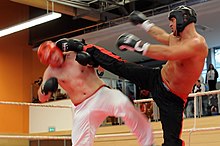Kickboxing

Kickboxing (also called kickboxing ) is a martial art in which hitting with feet and hands is combined with conventional boxing , as in martial arts ( karate or taekwondo ) . In the individual schools and sports associations there are different rules as to whether the opponent may be held or which hit areas are allowed on the opposite side. Low kicks are always taboo, but some associations allow kicks on the thighs ( low kicks ). Depending on the association, the use of hand twist strokes and foot sweeps (techniques with which the opponent is thrown off balance) is also regulated differently. Common to all associations is the prohibition of hitting on the back and on opponents who are lying on the ground, as well as the throwing of the competitor.
Kickboxing as a competitive discipline goes back to 1974, when it was called “All Style Karate”, “Sport Karate” or “Contact Karate”. This year, the founders of the WAKO (World Association of Kickboxing Organizations), Mike Anderson, Georg F. Brückner and others, agreed to use traditional Far Eastern fighting methods such as Taekwondo , Karate , Kung Fu , etc., for a sporting competition with uniform rules to do and compete against other combat systems.
Although kickboxing is a modern, occidental martial art, training and competition have many similarities with traditional boxing , savate and muay thai .
Degrees and belts
Similar to karate and other martial arts, the trainees in some kickboxing associations can achieve degrees ( Kyū / Dan ), which are marked by a colored belt. At the beginning you don't have a belt, one speaks of the white belt. Afterwards, further degrees can be achieved through exams. As a result, the athletes wear the appropriate belt and often receive a certificate of successful examination. The black belt corresponds to the master degree (Dan). After that, further master degrees can be achieved through special exams, in most associations exams up to 4th Dan are possible. Often, however, these DAN degrees are awarded to people who have made a name for themselves in this sport. These include long-time trainers and successful fighters.
Types of competition
There are different types of competition in which opponents of the same weight class face each other in the ring or on the mat (tatami).
Semicontact
In this discipline, also known as pointfighting, the fight is briefly interrupted after each successful hit on the opponent's body, and the fighters return to their starting position. Each hit will be evaluated by three judges during this short break. If the judges cannot agree on an evaluation, there is no point, because the techniques should be carried out cleanly and clearly. Ultimately, whoever is awarded the most points wins.
Semi-contact fights are often fought on mats and not in the boxing ring. The size of the fighting area varies between 5 × 5 and 8 × 8 meters.
Every clean technique that reaches a permitted target and hits it with light contact is rated with the following hit points depending on the level of difficulty (the points can vary for different associations):
- 1 point for permitted hand techniques of all kinds to the body
- 1 point for permitted foot techniques of all kinds to the body
- 1 point for foot sweeps, clear breaking of balance
- 1 point for permitted striking techniques of all kinds to the head
- 2 points for allowed kicking techniques of all kinds to the head
- 2 points for foot sweeps with immediate follow-up technique
- 2 points for allowed jump kicks to the body
- 3 points for permitted jumping foot techniques of all kinds to the head
Light contact
In light contact, the fight is usually on mats. The goal is to get more hits than your opponent. In contrast to the semi-contact, there is no interruption after each hit, but the fight continues. The wearing of protective equipment (closed, mostly 10 oz gloves for men, 10 oz for women, foot and shin protection, head protection, groin protection, chest protection for women and of course a bit protection) is mandatory. Light contact is technically and, above all, physically very demanding and demanding. Each round is to be assessed individually by each judge. The evaluations of a round should be based on the number of actual hits. In addition, an auxiliary point for better technique and tactics can be awarded after each round, which is composed according to the following criteria:
- Effectiveness of the attacks
- Ability to combine
- Fighting style cleanliness
- Defense effectiveness
- Balance of hand and foot techniques
- Overall impression of the athletic performance
The criteria according to which the auxiliary point is composed apply both to light and full contact.
Full contact
In contrast to the other fighting styles, the full contact version of kickboxing is played in a boxing ring. The fight can not only be won through points, but also through KO. This can take place through knockdown of the opponent (KO) as well as through the opponent's incapacity to fight (technical KO). In some full contact fights, kicks against the thighs are allowed (full contact with low kicks).
Scoring (the information may vary depending on the respective association):
- 1 point for permitted hand techniques of all kinds to the head or body
- 1 point for allowed foot techniques on the thigh (only for full contact with low kicks)
- 2 points for permitted foot techniques of all kinds to the body
- 3 points for permitted jumping foot techniques of all kinds to the head
- −1 point for strokes below the belt. (Here the area directly below the belt, i.e. the step, is meant. As already mentioned above, the kick to the thigh can be allowed. This depends on the association. An agreement between the responsible persons and the fighters or kickboxing stables is also possible. This is often the case when the fighters fight in different associations and the rules and regulations differ on this point.)
K-1
This set of rules, which was developed by the Japanese martial arts organization K-1 and has many similarities with Thai boxing, has also been included in their program by traditional kickboxing associations such as the WAKO due to the popularity of the K-1 competitions . In addition to low kicks, knee kicks to the head and body of the opponent are also allowed.
Scoring (the information may vary depending on the respective association):
- 1 point for hand and foot techniques to the body, head or leg
- 1 point for foot sweep (clear breaking of balance, opponent goes down)
- 1 point for jumping kicks to the head or body
- 1 point for knee strike or jumped knee strike to the body or head
- 1 point for knee strike to thigh
decisions
The following decisions can end a fight:
- Victory through precipitation - KO in full contact and also in some situations in light contact
- Victory by giving up a fight
- Victory by cancellation due to technical superiority only in semi-contact if the hit difference is 10 rating points.
- Victory by breaking off a fight due to incapacity to fight or defend yourself or athletic inferiority
- Termination due to injury
- Victory by scoring
- Victory by disqualifying the opponent
- A draw cannot be given in the tournament. It may only take place in individual, friendship or team fights.
- Victory by not showing up
- Termination without decision , if the fight can no longer be continued according to the rules as well as due to force majeure (damaged ring, failure of the lighting, etc.)
Age groups
- Men are all athletes who have reached the age of 18 up to the age of 40.
- Women are all athletes who have reached the age of 16 up to the age of 40.
- Juniors are all male athletes who have reached the age of 16 and have not yet reached the age of 18.
- Young people in semi-contact are all athletes who have not yet reached the age of 16.
- Young people in light contact are all athletes who have reached the age of 13 and have not yet reached the age of 16.
- Seniors , also known as veterans , are those athletes who have reached the age of 35 up to the age of 50.
Fighters under the age of 18 may only take part in tournaments with written permission from their legal guardian. In the year in which an athlete turns 16 or 18, he is entitled to continue fighting in the age group that started at the beginning of the year. The fighter can also start in the new age group, but cannot compete in two different age groups in a tournament.
Weight classes
Semi and light contact
Men and juniors
- Fly weight up to 57.0 kg
- Lightweight up to 63.0 kg
- Welter weight up to 69.0 kg
- Medium weight up to 74.0 kg
- Average weight up to 79.0 kg
- Lightweight up to 84.0 kg
- Cruiser weight up to 89.0 kg
- Heavy weight up to 94.0 kg
- Super heavy weight over 94.0 kg
Women
- Feather weight up to 50.0 kg
- Lightweight up to 55.0 kg
- Average weight up to 60.0 kg
- Lightweight up to 65.0 kg
- Heavy weight up to 70.0 kg
- Super heavy weight over 70.0 kg
Full contact / K-1
Men and juniors
- Fly weight up to 51.0 kg
- Bantam weight up to 54.0 kg
- Feather weight up to 57.0 kg
- Light weight up to 60.0 kg
- Half welter weight up to 63.5 kg
- Welter weight up to 67.0 kg
- Medium weight up to 71.0 kg
- Average weight up to 75.0 kg
- Lightweight up to 81.0 kg
- Cruiser weight up to 86.0 kg
- Heavy weight up to 91.0 kg
- Super heavy weight over 91.0 kg
Women
- Bantam weight up to 48.0 kg
- Feather weight up to 52.0 kg
- Lightweight up to 56.0 kg
- Average weight up to 60.0 kg
- Lightweight up to 65.0 kg
- Heavy weight up to 70.0 kg
- Super heavy weight over 70.0 kg
Olympic ambitions
Related martial arts such as boxing or taekwondo are represented in the program of the Olympic Games. Karate has a worldwide presentation stage at the World Games . The endeavor to make kickboxing an Olympic sport is pursued with commitment at the association level. The recognition of the anti-doping guidelines of the IOC and the membership in the GAISF can be understood as intermediate stages on the way to the Olympic competition program. Ultimately, actually achieving this will be very difficult, not least because of the IOC's interest in not letting the games get out of hand. Kickboxing has been part of the World Combat Games program since 2010 .
International trade associations
- Glory (Martial Arts Organization) (Glory)
- World Kickboxing and Karate Union (WKU)
- World Association of Kickboxing Organizations (WAKO)
- World Karate and Kickboxing Commission (WKC)
- World Kickboxing Federation (WKF)
- International Sport Karate Association (ISKA)
- World All Fight Symstem Organization (AFSO)
- World Tradition Karate Association (WTKA)
See also
Web links
- World Kickboxing Union Germany http://www.kickboxing.de
- Federal performance center of the WKA


